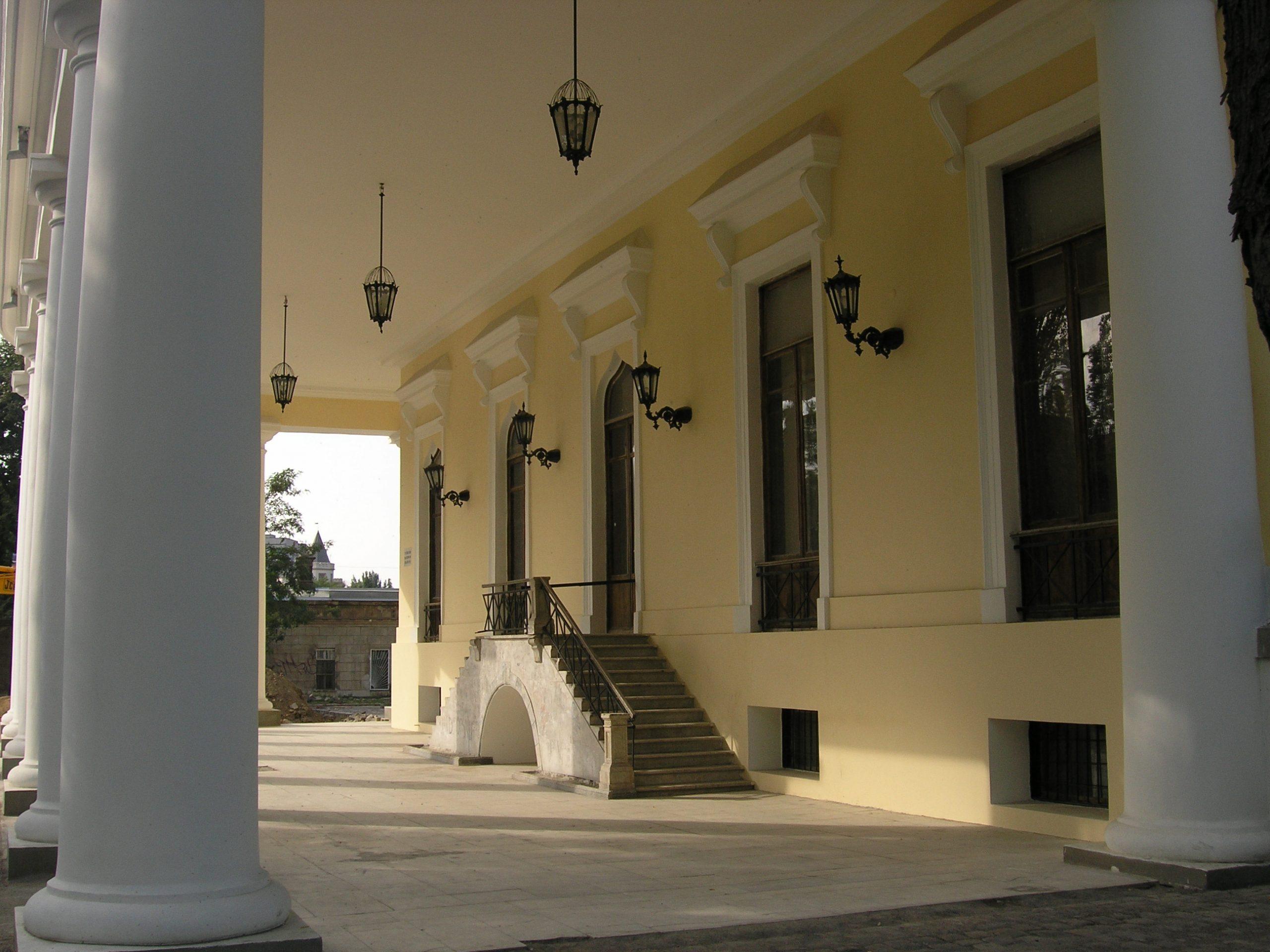Castles and Manors of Odessa region
After countless wars, partitions and other political and social turbulences, the castles and manors are now part of Odessa’s historical heritage. And there are plenty of stories to be told, some are facts, other just the legends but they always belong to a place.
Vorontsov Palace
2a, Vorontsovsky lane

Vorontsov Palace is a cultural and historical monument of Odessa. It is located on Primorsky Boulevard, to the left side of the Duke monument, in the lane of the same name - Vorontsovsky lane. The palace was built on the site of a Turkish fortress captured under the leadership of José Deribas, and was the residence of the Governor-General Mikhail Vorontsov.
The magnificent palace in the Empire style, built in 1827 by the architect Boffo, has survived to this day and has become one of the Odessa attractions.
The Vorontsov Palace is surrounded by an open terrace facing the sea. The inner side of the palace is decorated with high columns of the Tuscan order with a portico; tiles with Arabic script are visible on the walls, reminiscent of the Turkish campaign of its owner. In the depths of the portico, there is a two-way bridge - the staircase of the main entrance, and on its roof there is a walking gallery with many cast-iron lanterns along the perimeter of the balustrade. On the side there is another portico, consisting of four columns, where you can see a miraculously preserved cast "three-headed" lantern.
Previously, the Vorontsovs' palace and estate were fenced off from Primorsky Boulevard with a beautiful wrought-iron lattice. And the entrance was guarded by stone lions, planted on high pylons. In addition to the guard, two more lion heads, with rings in their teeth, were mounted in the grille. Once upon a time life was in full swing here: balls and receptions were held, the front doors were wide open, the lights were on in the large palace windows, speech was heard in all European languages ​​and there was talk about politics, trade and, of course, about love.
The interiors of the palace, created by the famous master, sculptor and painter Carlo Scotti - were truly luxurious. Lush gilding, rich stucco and expensive mosaics, Corinthian pilasters with semicircular niches for statues are all around. The fireplaces were distinguished by a special decoration: the birds and plants depicted on them were made of multi-colored stones. Taste and elegance were felt in everything - from amber door handles to ceiling paintings. Eyewitnesses of that time noted that the Vorontsov Palace was many times superior to its Italian counterparts in decoration and ornaments.
The famous palace has become a witness of many events in its lifetime. In 1854, on April 10, like the monument to Duke, it was subjected to blows by the British-French squadron during the Crimean War and was partially destroyed. It is interesting that the greatest treasure at that time for Vorontsov was not so much the palace itself as his books - the rich library. He gave the order to “securely hide rare books,†thanks to which the library was preserved and later donated to the university, where it is kept till today under the name of “Vorontsov Fundâ€.
During the revolution of 1917-1920, over the former mansion of Count Vorontsov a red flag fluttered in the wind, a machine gun stood on the balcony, and the Soviets Deputies and the Red Guard headquarters were located here. It survived during the Second World War, but lost the Oryol Corps as part of the estate, which was destroyed in 1944. The Vorontsov fountain, a side wing and a beautiful cast-iron fence have also sunk into oblivion.
Since 1936, it has been turned into the Pioneer's Palace. Currently, the building belongs to the Palace of Children's and Youth Creativity. It is not possible to visit the palace on an excursion or an event - restoration is underway in our time.





Palace of Counts Tolstoy (House of Scientists)
4, Sabaneyev Bridge Street

If you walk from Gogol Street in the direction of the monument to Catherine the Great, then at the very beginning of the Sabaneyev Bridge you cannot fail to notice the palace that once belonged to hereditary nobles - Count Tolstoy.
The Palace was built in 1832 in the style of Russian classicism according to the project of the very famous Italian architect Boffo for the chamber-junker Horvat. But in 1867 Count Tolstoy bought the palace. It has 2 floors and 12 rooms with luxurious interiors. By 1898, next to the count's estate, there was already a completed late Baroque mansion, which houses a magnificent art gallery. Its architect is G.K.Sheurembrandt.
The most beautiful room of the palace is considered the Marble Living Room, which was used by the Tolstoy as a dining room. It is decorated with artificial marble along the entire perimeter. Here you can see an incredibly beautiful grand piano, the owner of which was the famous Hungarian composer Ferenc Liszt. The splendor and sophistication of the remaining rooms of the palace - the Silk Drawing Room, the White Hall, the Walnut and Oak Drawing Rooms, will not leave you indifferent either. In addition, a wonderful garden adjoins the palace building.
Historians claim that the palace was acquired by Count Mikhail Mikhailovich Tolstoy for his love one, Elena Smirnova, who was a simple laundress.
With the advent of Soviet power, Tolstoy had to leave his mansion. The family emigrates to France, then Switzerland. Leaving for Count M.M. Tolstoy gave the city public library his entire personal collection of books, which he had collected for many years in Russia and abroad. In Geneva, E.G. Tolstaya at the age of 78 in 1926 and M.M. Tolstoy 64 years old in 1927 has died. In 1934, the Odessa House of Scientists moved to the former Tolstoy mansion, where it operates continuously to this day. Today the palace is visited by thousands of tourists every year.







Photo credit: ArchOdessa
Read Castles and Manors of Odessa Chapter 1 here
Shah's Palace
2, Gogol street

Shah's Palace is one of the unique majestic buildings that have survived to this day. You will certainly see him, walking along the Mother-in-law bridge to 2, Gogol street.
The history of the name of this castle is interesting. The word "Shah" has an obvious oriental flavor and inevitably suggests the existence of some kind of shah. There really was a shah here, it is Mohammed Ali, the former ruler of Iran (Persia) from the Qajar dynasty. In 1909, fate turned out to be unfavorable to him: 37-year-old Mohammed was dethroned and sent into exile, and his 11-year-old son, Sultan-Ahmad, took the place of the shahinshah. In search of a new home, Mohammed arrives in Odessa.
Of course, this city does not leave him indifferent, and he settles in this beautiful castle, renting it. Accustomed to the lush harem life, the shah of course could not remain here alone, so as in his homeland, he surrounds his person with numerous servants and a harem of 50 concubines. In one of his letters to the English Prime Minister Gladstone, Mohammed Ali, either jokingly or seriously wrote that "it is better to live 50 years with one wife than one year with 50 wives." They say that he did not send the guilty concubines out through the doors, but through the balcony of the first floor, for their edification and for the laughter of people.
The castle was built by the Polish architect Felix Gonsiorovsky in 1852 for the landowner Zenon Brzhozovsky, also of Pole origin. The palace was erected in the neo-Gothic style from a stone: shell rock. Inkerman stone brought from the Crimea was used for facade facing the sea. Thanks to its powerful, impregnable walls, towering crenellated towers and pointed arches, it seems to be fanned by the aura of the Middle Ages.
After the 1917 revolution, the building became state property. Its appearance was not given due attention, and appropriate restorations were not carried out. Moreover, this mansion, as well as office buildings and courtyard buildings, were often used for various organizations and institutions. Repairs were carried out here, each to its own taste and mood, and all kinds of redevelopment. Such a ruthless approach did not contribute to the preservation of the cultural heritage in its original form.
Its interiors were lost: descendants will no longer be able to see the most beautiful marble decor, tiled fireplaces and parquet floors, antique furniture, paintings and statues. Fortunately, the architectural ensemble has not changed significantly. Thanks to the major restoration of 2000-2004, the Shah's palace received a new life. The tourists can admire this man-made intricate beauty only from the outside: the internal premises there were occupied by the office of the Odessa bank, and now the office of the transshipment company.
























